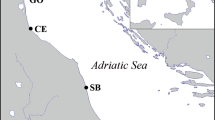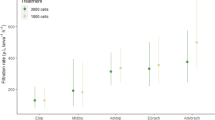Abstract
Rates of calcium incorporation by selected tissues of Crassostrea virginica increased in a step-wise fashion from lowest values among organisms exposed to ambient total calcium concentrations of 45 mg l-1, intermediate values among oysters exposed to 135, 225, and 315 mg l-1, to highest rates for oysters exposed to 360 mg l-1. Although excised visceral mass tissue had highest rates of calcium incorporation relative to mantle, muscle, and both organic and inorganic portions of the shell, mantle tissue appeared to have the most dynamic response to changes in ambient calcium concentrations. Rates of dissolved calcium incorporation from ambient water were approximately two to three orders of magnitude higher than comparable rates from ingested algal food. Behavioral response to concentrations of selected inoic, species in the ambient environment may have been responsible for observed differences in rates of calcium incorporation.
Similar content being viewed by others
Literature Cited
Astin, M. et J. Maetz: Permeabilite au calcium du manteau de lamellibranches d'eau douce etudiée a l'aide des isotopes 45Ca et 47Ca. Biochim. biophys. Acta 88, 225–227 (1964).
Bevelander, G.: Calcification in mollusks. III. Intake and deposition of 45Ca and 32P in relation to shell formation. Biol. Bull. mar. biol. Lab., Woods Hole 102, 9–15 (1952)
Brink, F.: The role of calcium ions in neural processes. Pharmac. Rev. 6, p. 243 (1954)
Chance, B.: The energy-linked reaction of calcium with mitochondria. J. biol. Chem. 240, p. 2729 (1965)
Conger, K.A., M.L. Swift, J.B. Reeves and S. Lakshmanan: Shell growth of unfed oysters in the laboratory: a sublethal bioassay system for pollutants. Life Sciences 22, 245–254 (1978)
Frankenhaeuser, B. and A.L. Hodgkin: The action of calcium on the electrical properties of squid axons. J. Physiol., Lond. 137, p. 218 (1957)
Greenaway, P.: Calcium regulation in the freshwater mollusc, Limnaea stagnalis (L.) (Gastropoda: Pulmonata). I. The effect, of internal and external calcium concentration. J. exp. Biol. 54, 199–214 (1971)
Guillard, R.R.L. and J.H. Ryther: Studies of marine planktonic diatoms. I. Cyclotella nana Hustedt and Detonula confervacea (Cleve) Gran. Can. J. Microbiol. 8, 229–239 (1962)
Hopkins, A.E.: Adaptation of the feeding mechanism of the oyster (Ostrea gigas) to changes in, salinity. Bull. Bur. Fish., Wash. 48, 345–363 (1936)
Jodrey, L.H.: Studies, on shell formation. III. Measurement of calcium deposition in shell and calcium turnover in mantle tissue using the mantle-shell preparation and Ca45 Biol. Bull. mar. biol. Lab., Woods Hole 103, 269–276 (1953)
Kester, D.R., J.W. Ovedall, D.H. Connors and R.M. Pytkowicz: Preparation of artificial seawater. Limnol. Oceanogr. 12, 176–179 (1967)
Landowne, D. and J.M. Ritchie: On the control of glycogenolysis in nervous tissue by calcium. J. Physiol. 212, p. 503 (1971)
Loosanoff, V.L. and P.B. Smith: Some aspects of behavior of oysters accustomed to different salinities. Anat. Rec. 105, p. 627 (1949)
Papero, A. and J.A. Murphy: The effect of calcium on the rate of beating of lateral cilia in Mytilus edulis. I. A response to perfusion with 5-HT, DA, BOL, and PBZ. Comp. Biochem. Physiol. 50C 15–20 (1975)
Rasmussen, H. and N. Nagata: Hormones, cell calcium and cyclic AMP. In: Calcium and cellular function, p. 198. Ed. by A.W. Cuthbert. London: Macmillan 1970
Schlieper, C.: Osmotic resistance of gills of Mytilus. Helgoländer wiss. Meeresunters. 14, 482–502 (1966)
Shumway, S.E.: Effect, of salinity fluctuation on the osmotic pressure and Na+, Ca2+, and Mg2+ ion concentrations in the hemolymph of bivalve molluscs. Mar. Biol. 41, 153–177 (1977)
Van der Borght, O. and S. Van Puymbroeck: Active transport of alkaline earth ions as physiological base of the accumulation of some radionuclides in freshwater molluscs Nature, Lond. 204, 583–584 (1964)
——: Calcium metabolism in a freshwater mollusc: quantitative importance of water and food as supply for calcium during growth. Nature, Lond. 210, 791–793 (1966)
Wheeler, A.P., P.L. Blackwelder and K.M. Wilbur: Shell growth in the scallop Argopecten irradians. I. Isotope incorporation with reference to diurnal growth. Biol. Bull. mar. biol. Lab., Woods Hole 148, 472–482 (1975)
Wilbur, K. and L.H. Jodrey: Studies on shell formation. V. The inhibition of shell formation by carbonic anhydrase inhibitors. Biol. Bull. mar. biol. Lab., Woods Hole 108, 359–365 (1955)
Author information
Authors and Affiliations
Additional information
Communicated by I. Morris, West Boothbay Harbor
Rights and permissions
About this article
Cite this article
Sick, L.V., Johnson, C.C. & Siegfried, C.A. Fluxes of dissolved and particulate calcium in selected tissues of Crassostrea virginica . Mar. Biol. 54, 293–299 (1979). https://doi.org/10.1007/BF00395435
Accepted:
Issue Date:
DOI: https://doi.org/10.1007/BF00395435




